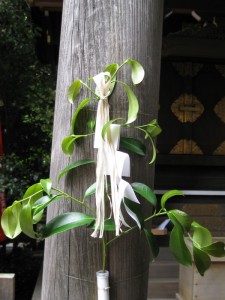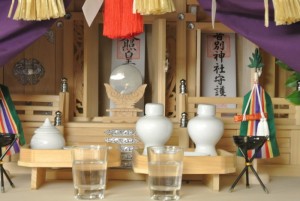
Death is usually associated with Buddhist practices, as pictured here, but Shinto funerals take a slightly different form
3. Announcement of the death (to the ancestral altar, and shrines connected to the deceased.)
The Shinto death is reported to the kami (either in the family kamidana [house altar] or at a shrine). If the deceased or relatives had prayed for a cure at a certain shrine, then a visit should be paid to that shrine in order to announce the death. If the shrine is far away, then a representative can be sent or the family can “pray from afar”. The death may also be reported to the ancestors (who are kami, after all) at the place within the house where ancestral rites are conducted (usually the ancestral altar, but sometimes the kamidana).
After the announcement, a white piece of paper is pasted over the kamidana in order to insulate the kami from the impurity of death. The soreisha, which houses the ancestral tablets of a Shinto family, is also covered with a sheet of white paper. In contrast, a Buddhist household covers the kamidana but not the butsudan [Buddhist altar], since the Buddhist ancestors do not need to be sealed off from the impurity of death. It is the chief mourner, the most polluted person, who covers the soreisha with the white paper.
4. Pillow decorations
The body of the deceased is placed with his head pointing north or to the right (from the point of view of the mourners facing it). The face is covered with a white cloth. Behind him is a plain white folding screen, which may be provided by the funeral company.
On a small table of unvarnished wood, the relatives set out food offerings for the deceased. The low table used for Shinto pillow decorations is distinctive, made of plain wood, with four legs on each side, joined together at the bottom by a horizontal foot. The offerings are the deceased’s favorite foods, along with the characteristic Shinto offerings of sakaki, washed rice, salt, sake, and water (The Jinja Honchô manual specifies the deceased’s favorite foods or washed rice, salt, and water).
In addition, a protective sword or knife may be laid on top of the corpse, pointing away from his face, or set out on a separate table (the preferred Shinto arrangement). An ordinary knife or even a razor may stand in for the sword, but the funeral company will supply a sword. For women, a mirror may be used instead of a sword (to deflect, rather than cut down, the forces, never clearly named, that hinder one’s journey to the netherworld).
For Buddhist pillow decorations, one might use candles, flowers, incense (usually one stick at a time), a bell, water, glutinous rice balls, and a bowl of rice with a pair of chopsticks stuck straight into the rice.

Sakaki branch tied to a torii pillar
The tree used in Buddhist pillow decorations is the shikimi ([illicium religiosum]) — also written, significantly, with a made-in- Japan character consisting of “tree” plus “Buddha”, a perfect counterpoint to the character for sakaki, which is comprised of “tree” plus “kami”
The chart below shows a clear pattern of differences between the Shinto and Buddhist pillow decorations.
Shinto kami tree (sakaki); uncooked rice / for the gods; water / for the gods; salt; sake; [sometimes tamagushi]; [sometimes one or two candlesl
Buddhist – Buddha tree (shikimi); flowers (“living”); cooked rice / for the dead; water / as though for the living; dango dumplings; bell; incense; one or two candles; favorite foods of the deceased
The Shinto dead eat uncooked rice that is not normally eaten by a civilized Japanese person. (Raw rice is eaten at certain Shinto ceremonies as part of the naorai, a shared meal in the presence of the kami. This is another example of the kami’s preference for uncooked food. In the Tenrikyô religion, raw rice is used as spiritual medicine. Both these examples illustrate the fact that raw rice, usually “less than” food, becomes “more than” food in certain ritual settings.)
Both the Buddhist and Shinto dead drink water. But the Buddhist dead drink it out of a regular glass or teacup, even a mug. In contrast, the Shinto dead drink their water from the container used at Shinto rituals. Here again, the details of presentation can be matched with patterns of food symbolism to demarcate the Buddhist vs. Shinto dead.

Offerings of sake and salt at a shrine


Leave a Reply